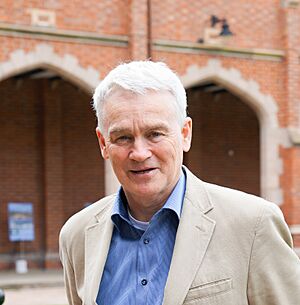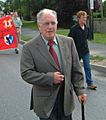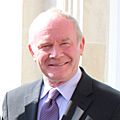Provisional Irish Republican Army facts for kids
Quick facts for kids Provisional Irish Republican Army |
|
|---|---|
| Irish: Óglaigh na hÉireann | |

A Provisional IRA badge, with the phoenix symbolising the group's origins.
|
|
| Leaders | IRA Army Council |
| Dates of operation | 1969–2005 (on ceasefire from 1997) |
| Allegiance | |
| Active regions | Ireland, England, Europe, |
| Ideology |
|
| Size | 10,000 est. throughout the Troubles |
| Allies |
|
| Opponents | Ulster loyalist paramilitaries
|
| Battles and wars | The Troubles |
|
|
|
The Provisional Irish Republican Army (Provisional IRA), also known as the IRA or the Provos, was an Irish republican group. Its main goal was to end British rule in Northern Ireland and create a united, independent republic that included all of Ireland. It was the most active republican group during a period known as the Troubles. The Provisional IRA believed it was the true army of an all-island Irish Republic, following in the footsteps of the original IRA from the Irish War of Independence. Both the United Kingdom and the Republic of Ireland considered it a forbidden or unlawful group.
Contents
The Provisional IRA: A Brief History
The Provisional IRA was formed in December 1969. This happened because of a disagreement within the older IRA and the wider Irish republican movement. At first, the Provisional IRA was smaller than another group called the Official IRA. However, by 1972, it had become the stronger group.
How the Troubles Began
The Troubles started when a mostly Catholic group began a peaceful movement for civil rights. This movement faced violence from groups who supported British rule (called Ulster loyalists) and the local police, known as the Royal Ulster Constabulary (RUC). This led to riots in August 1969 and the arrival of British soldiers.
The IRA's Actions and Support
The IRA first focused on protecting Catholic areas. But in 1970, it started an offensive campaign. It received help from Irish communities living abroad and from leaders like Muammar Gaddafi of Libya and the Palestine Liberation Organization. The IRA used guerrilla tactics, which are surprise attacks, against the British Army and the RUC. They operated in both cities and rural areas. They also carried out bombings in Northern Ireland, England, and other parts of Europe. These attacks targeted military, political, and economic places.
Ending the Conflict
The Provisional IRA announced a final ceasefire in July 1997. After this, its political partner, Sinn Féin, joined peace talks about the future of Northern Ireland. These talks led to the Good Friday Agreement in 1998. In 2005, the IRA officially ended its armed campaign. It also gave up its weapons under the watch of the Independent International Commission on Decommissioning. Some smaller groups have since formed from the IRA, like the Continuity IRA and the Real IRA.
How the Provisional IRA Was Organized
The Provisional IRA had a structured way of making decisions.
Decision-Making and Leadership
The highest decision-making body was the General Army Convention. All members could send representatives to this meeting. It was supposed to happen every two years, or every four years after 1986. Before 1969, these meetings were regular. But during the armed campaign, it was hard to gather so many people in secret. So, conventions were held less often. After the 1997 ceasefire, they happened more frequently.
The convention elected a 12-member Executive. This Executive then chose seven members to form the Army Council. The Army Council was in charge of daily operations. It set policies, made big decisions, and appointed a chief-of-staff.
Headquarters and Departments
The chief-of-staff had help from an adjutant general and a General Headquarters (GHQ) staff. This staff included people in charge of:
- Weapons and supplies (quartermaster general)
- Money (finance)
- Making bombs (engineering)
- Training
- Information gathering (intelligence)
- Public relations (publicity)
- Planning attacks (operations)
- Keeping things secret (security)
The quartermaster general's department was the largest. It was responsible for getting weapons, smuggling them into Ireland, hiding them, and giving them to IRA units when needed. The engineering department was also important, as it made improvised explosive devices (homemade bombs) and mortars.
Commands and Units
Below GHQ, the IRA was split into a Northern Command and a Southern Command.
- Northern Command operated in Northern Ireland and nearby border counties.
- Southern Command operated in the rest of Ireland. Its main job was to support Northern Command. This included bringing in and storing weapons, providing safe houses, raising money, and organizing training camps.
There was also an England department, which was separate from other IRA structures. This department was responsible for the bombing campaign in England.
Local Organization
The IRA called its regular members "volunteers." This showed that people joined willingly and could leave at any time. Until the late 1970s, volunteers were organized like a regular army, with companies, battalions, and brigades (like the Belfast Brigade).
By 1977, the IRA changed its structure to small, secret groups called active service units. These units usually had four to ten members. This change made it harder for security forces to find out about their plans. The older, larger structures were still used for support tasks, like gathering information or hiding weapons. The South Armagh Brigade was an exception; it kept its traditional structure. This brigade had very few arrests, making it hard for security forces to get information from them.
Impact and Casualties
The Provisional IRA was responsible for more deaths than any other group during the Troubles. Different studies have slightly different numbers, but they show the IRA's significant impact.
Deaths Caused by the IRA
According to the Conflict Archive on the Internet (CAIN), the IRA was responsible for 1,705 deaths. This was about 48% of all deaths during the conflict.
- About 1,009 (59%) were members or former members of the British security forces.
- About 508 (29%) were civilians.
Another study, the book Lost Lives, states the IRA was responsible for 1,781 deaths (about 47% of the total).
- About 944 (53%) were members of the British security forces.
- About 644 (36%) were civilians. This civilian number includes people who worked for British security forces, politicians, judges, and people accused of being criminals or informers.
Overall, the IRA was responsible for a large percentage of deaths among British security forces (87–90%) and civilians (27–30%).
IRA Members Killed
Between 275 and 300 IRA members were killed during the Troubles. The biggest loss of life for the IRA in one event was the Loughgall ambush in 1987. In this incident, eight volunteers trying to bomb a police station were killed by the British Army's Special Air Service.
Images for kids
-
The Proclamation of the Irish Republic, issued during the 1916 Easter Rising against British rule in Ireland
-
Ruairí Ó Brádaigh, a former chief-of-staff of the pre-1969 IRA, was part of the first Army Council of the Provisional IRA in 1969.
-
Martin McGuinness was part of an IRA group that met with British politician William Whitelaw for peace talks in July 1972.
-
Memorial to the victims of the Birmingham pub bombings, which killed twenty-one people in November 1974.
See also
 In Spanish: Ejército Republicano Irlandés Provisional para niños
In Spanish: Ejército Republicano Irlandés Provisional para niños








